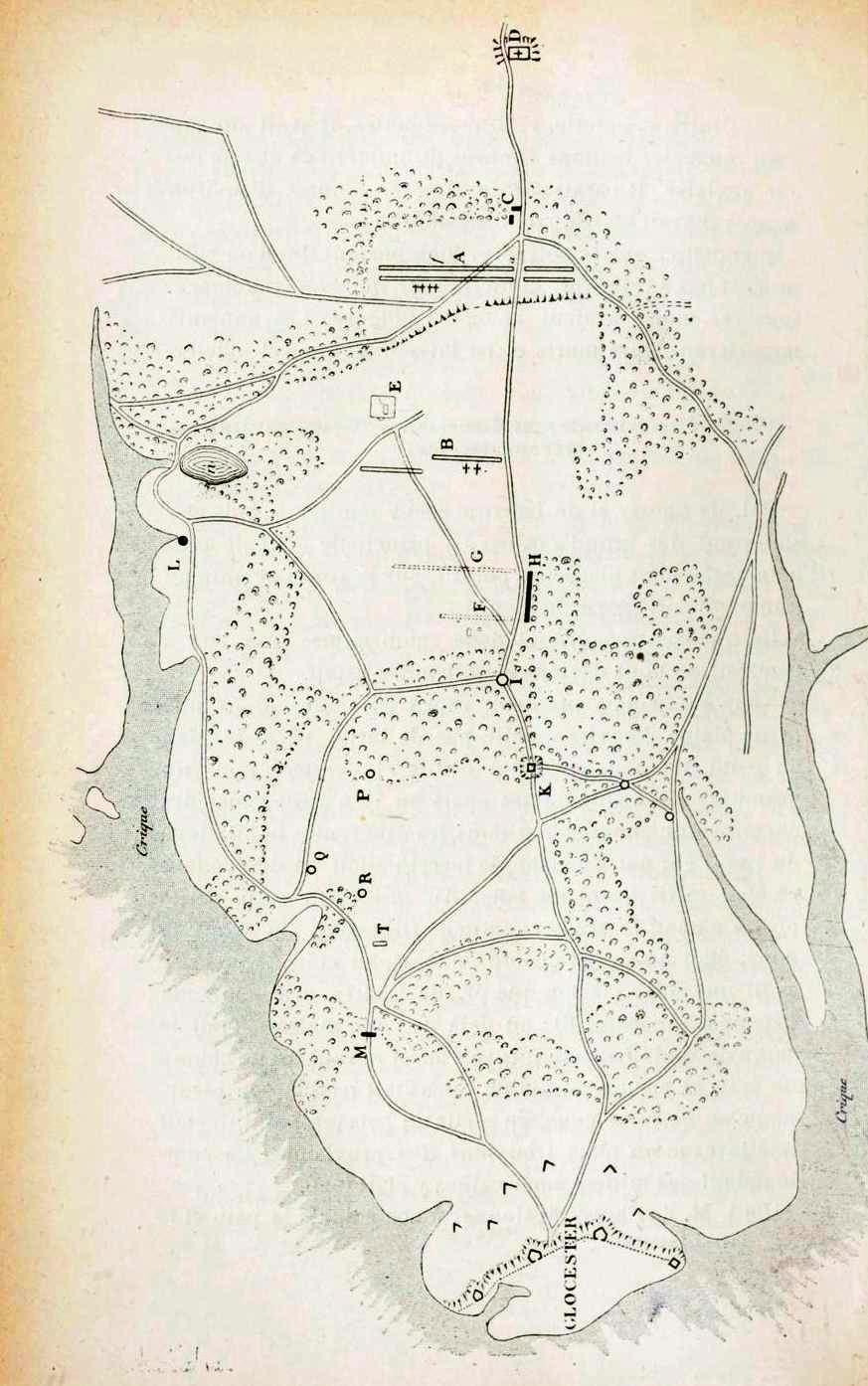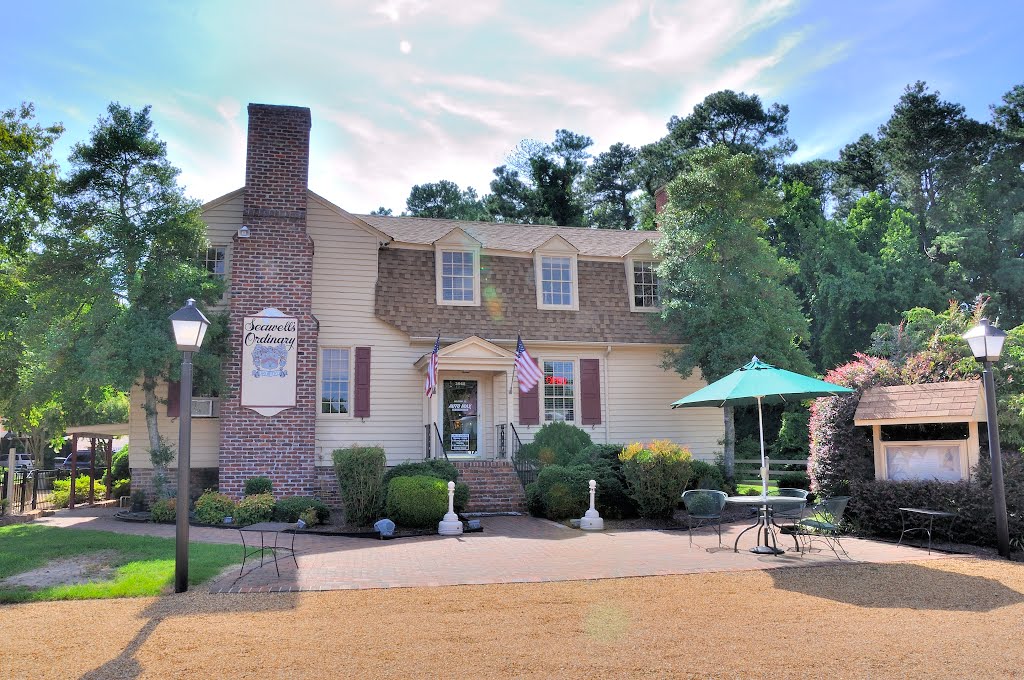Mercer’s Grenadier Militia
![]() This is part two in the series by guest historian Drew Gruber. For part one, click here.
This is part two in the series by guest historian Drew Gruber. For part one, click here.
On the morning of October 3, 1781, British Colonels Tarleton and Thomas Dundas led another expedition north towards Gloucester Courthouse and away from the protection of their fortifications at Gloucester Point. Their command that day included some of the most renowned fighting men then in service. Cavalry and mounted infantry from Tarleton’s own British Legion, combined with a detachment of Colonel Simcoe’s Queen’s Rangers, elements of the 17th Dragoons, men from the 23rd Regiment (Royal Welch Fusiliers), German Jaegers and part of the 80th Regiment of Foot provided an impressive host for their American and French adversaries. Captain Johann Ewald, commander of the Jaegers commented after the war that he was sent out with “one hundred horse of Simcoe’s and the remainder of the jagers and rangers, which amounted to only sixty man in order to take a position between Seawell’s planatation and Seawall’s Ordinary. I was to form a chain there to protect a foraging of Indian corn.”[1]
Tarleton and Ewald commented that sometime after 10am, with the foraging complete, the rearguard under Ewald was pressed closely by hostile horsemen.[2] Ewald intended to retire and form an ambush but was too closely pursued by Lauzun. The French troopers had outpaced the American and French infantry, gaining the vital road intersection near Seawell’s Ordinary and had pressed the British too closely causing their mounted troops to turn and confront Lauzun’s men. It was across Seawell’s fields that the French, British, and Loyalist troopers, perhaps near 600 in number, met utilizing lances, pistols, carbines, and sabers in a deadly melee. Seeing Tarleton knocked from his horse nearer the French troopers than their own the “…English rear guard set out full speed from its distant situation, and arrived in such disorder, that its charge was unable to make impression up on the Duke of Lauzun’s hussars…”[3] While disorganized, this determined counter-attack enabled Tarleton to remount and begin coordinating a stronger response to the French push.
According to several sources it was during this brief lull that Weedon’s infantry began to arrive on the field. Lauzun’s troopers were attempting to reform their ranks as British and loyalist forces began another push forward in an attempt to regain the initiative. Mercer’s men were well ahead of the remainder of Weedon’s column, having apparently ran towards the sound of the battle. Passing the vital intersection and through the farm lane they charged into the field surrounding Seawell’s Ordinary. It was the opportune moment. The Grenadiers must have kept up a hot fire, holding their own for several minutes if not longer. Pensioner John White recalled that “he was in an engagement with the enemy at Seawell’s in which he fired thirteen rounds and his officers thought that he killed one of the British officers…”[4] Henry Lee recounted in his Memoirs of the War that Mercer’s men “had expended nearly all its cartridges.”[5]

(Courtesy of Drifting Focus Photography. http://photography.driftingfocus.com/)
The arrival and deployment of Mercer’s men on the field, especially with such alacrity and apparent firepower was enough to rebuff the British efforts. Although his description of the battle on October 3, 1781 is rather scant, Tarleton comments that after receiving fire from “numerous militia” who were behind a rail he “again ordered the retreat to be sounded.”[6] Charles Bettisworth, a flugleman in Weedon’s brigade observed the conduct of Mercer’s men that morning: “Mercers Corps of Grenadiers who dashed forward in advance of the army encountered them and put them to flight killing their colonel &c & taking 2 of the Queens Rangers prisoner before Weedens brigade got near enough to take part in the engagement.”[7]
Mercer recounted this engagement in a letter to a friend over twenty years later:
“The horse of the enemy had approach’d within 250 yards & the infantry were not at more than 150 yards distance, when the firing began. No regular troops cou’d behave with more zeal & alacrity than this corps of Militia; their sprits had been rais’d by running them up, and being hurried into action without time to reflect on their danger, they discovered as much gallantry & order as any regular corps that I ever saw in action.”[8]
The battle which began just after 10am was over within a few hours. Writing to Washington at 3pm that day, the General Marquis de Choisy reported that, “… grenadier Americains who were the only Infantry advanced enough to have part in the affair and who have behaved exceedingly well have Killed one officer who was at the head of the Infantry of the ennemi…”[9]

This short, rather sharp fight produced some significant casualties. Tarleton reported that of the entire command one officer and eleven men were killed or wounded and that the French had two officers and fourteen hussars killed and wounded. [10] Ewald reports similar numbers stating that one officer and four men were killed with nine men being wounded by lances.[11] The following day St. George Tucker noted that, “…our loss was three hussars kill’d, eleven and an officer wounded- the Enemy lost fift men in kill’d and wounded- the officer commanding the Infanrty was kill’d & Tarliton himself badly wounded.” [12] Although Tarleton was not wounded as Tucker reported, both Tarleton and Mercer commented about the loss of Lieutenant Mair (Moir) of the famed Royal Welch Fusiliers who fell within 10 paces of the Virginians.[13]
By early afternoon on October 3, 1781 the remainder of Weedon’s brigade as well as Choisy’s French infantry had arrived on the field. Taking advantage of the situation the coalition army pushed closer to Gloucester Point, effectively bottling up the crown forces in Gloucester. After closing off Cornwallis’ route of escape, Washington’s army would begin tightening their grip at Yorktown and within two week’s time on October 17, the guns would fall silent. Arguably, the French and American victory at Yorktown would have not been possible without the victory at Seawell’s Ordinary- thanks in large part to Mercer’s Grenadiers.

(Courtesy of Google Images)
While many people have looked into the Battle of Seawall’s Ordinary (often referred to as the Battle of the Hook) few have looked closely into the larger context, including the issues of manpower and materials which resulted in events on October 3, 1781. After six long years, including the disaster which befell Virginians at Charleston there was a decided dearth in both the number of recruits and zeal for the continued conflict. However, this prolonged struggle meant that the Virginia militiamen and draftees who met the British host during the Yorktown campaign were in a large part, no strangers to the rigors of active campaign and the expectations on the battlefield. Moreover, it should be noted the culling of specific troops such as Mercer’s Grenadiers is not an isolated or unique experience but is rather commonplace by 1781 as the evolutions of warfare in North America continued to push martial boundaries.[14]
Mercer’s Grenadiers have always made for a great story when taken out of context; the proverbial rifle-toting, citizen soldier, David who armed with righteousness and good old(e) American patriotism slayed the mighty, numerous ranks of the oppressive, oligarchic Goliath. In reality Mercer’s “old soldiers” had met and defeated their equals in Seawell’s fields- having kept up with and adapted to the changing pace of modern warfare.
Sources
[1] Johann Ewald, Diary of the American War, a Hessian Journal, trans. Joseph P. Tustin (New Haven: Yale University Press, 1979). Pages, 329, 330
[2] Banister Tarleton, A History of the Campaigns of 1780 and 1781 in the Southern Provinces of North America. (New York: Arno Press, 1969). Pages, 376-377.
[3] Ibid.
[4] Pension application, John White. W6476. Southern Campaign American Revolution Pension Statements & Rosters. < http://revwarapps.org/w6476.pdf>
[5] Henry Lee, Memoirs of the War in the Southern Department. Volume 2. (New York: Arno Press, 1969). Page 498.
[6] Banister Tarleton, A History of the Campaigns of 1780 and 1781 in the Southern Provinces of North America. (New York: Arno Press, 1969). Page, 378
[7] Pension application, Charles Bettisworth. S32117. Southern Campaign American Revolution Pension Statements & Rosters. < http://revwarapps.org/s32117.pdf>
A fugel or fugleman during the American Revolution is typically a veteran soldier who acts as a guide for the rest of the body in both the figurative and literal sense providing guidance as well as a point of reference during drills, etc.
[8] John F. Mercer, letter to Col. Simms. Fragments of Revolutionary History; Being Hitherto Unpublished. Edited by Gaillard Hunt, 1892. Pages, 55-56.
[9] Marquis de Choisy, letter to George Washington, 3 October, 1781. The Papers of George Washington, Founders Early Access, Rotunda, University of Virginia.
[10] Banister Tarleton, A History of the Campaigns of 1780 and 1781 in the Southern Provinces of North America. (New York: Arno Press, 1969). Page, 378
[11] Johann Ewald, Diary of the American War, a Hessian Journal, trans. Joseph P. Tustin (New Haven: Yale University Press, 1979). Page, 330.
[12] St. George Tucker, Journal of the Siege of Yorktown. Entry on October 4, 1781. Transcribed by Edward M. Riley. Encyclopedia Virginia. <http://www.encyclopediavirginia.org/_Journal_of_the_Siege_of_Yorktown_by_St_George_Tucker_1781>
[13] John F. Mercer, letter to Col. Simms. Fragments of Revolutionary History; Being Hitherto Unpublished. Edited by Gaillard Hunt, 1892. Pages, 55-56.
[14] Matthew H. Spring, With Zeal and With Bayonets Only: The British Army on Campaign in North America, 1775-1781. (Norman: University of Oklahoma Press, 2010)
The correct spelling is Royal Welch Fusiliers.